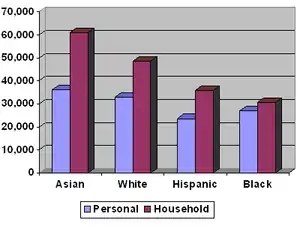 White Americans (alone/one race only) in 2020 | |
| Total population | |
|---|---|
| 235 million (71%) White, in combination with other races 204 million (61.6%) White, one race only [1] | |
| Regions with significant populations | |
| All areas of the United States | |
| Languages | |
| Predominantly English | |
| Religion | |
|
White Americans (also referred to as European Americans) are Americans who identify as white people. This group constitutes the majority of the people in the United States. According to the 2020 census, 71%, or 235,411,507 people, were White alone or in combination, and 61.6%, or 204,277,273 people, were White alone. This represented a national white demographic decline from a 72.4% white alone share of the U.S. population in 2010.
As of July 1, 2022, United States Census Bureau estimates that 75.8% of the US population were white alone, while Non-Hispanic whites were 59.3% of the population.[3] For these population estimates, the 15.1% who identified as "Some Other Race" in 2020[4] were redistributed into other racial categories, with most of them reclassified as white alone.[5] European Americans are the largest panethnic group of white Americans and have constituted the majority population of the United States since the nation's founding.
The U.S. Census Bureau uses a particular definition of "white" that differs from some colloquial uses of the term.[6][7] The Bureau defines "White" people to be those "having origins in any of the original peoples of Europe, the Middle East or North Africa".[8] Within official census definitions, people of all racial categories may be further divided into those who identify as "not Hispanic or Latino" and those who do identify as "Hispanic or Latino".[9][6] The term "non-Hispanic white", rather than just "white", may be the census group corresponding most closely to those persons who identify as and are perceived to be white in common usage; similarly not all Hispanic/Latino people identify as "white", "black", or any other listed racial category.[7][6] In 2015, the Census Bureau announced their intention to make Hispanic/Latino and Middle Eastern/North African racial categories similar to "white" or "black", with respondents able to choose one, two, or more racial categories; this change was canceled during the Trump administration.[7][10] Other persons who are classified as "white" by the U.S. census but may or may not identify as or be perceived as white include Arab Americans and Jewish Americans of European or MENA descent.[11][12][13][14] In the United States, the term White people generally denotes a person of European ancestry, but has been legally extended to people of West Asian and North African (Middle Eastern, West Asian, and North African) ancestry.[15][16][17]
The most commonly reported ancestries of non-Hispanic White Americans include German (13%), Irish (10%), English (9%), Italian (6%), French (4%), Polish (3%), Scottish (3%), Scotch-Irish (2%), and Dutch, Norwegian, Swedish, and Russian (each 1%), respectively.[18][19][20][21] It is difficult to track ancestry from Spain in Whites alone since people of Spanish descent are Hispanic and though the census does track Hispanics' national origin, it does not classify it by race. In 2021, 995,583 people of any race claimed ancestry from Spain, 0.3% of the total population.[22] The British Americans' demography is considered a serious under-count as the stock tend to self-report and identify as simply "Americans" (7%), due to the length of time they have inhabited the United States, particularly if their family arrived prior to the American Revolution.[23][14] The vast majority of white Americans also have ancestry from multiple countries.
Historical and present definitions
Definitions of who is "White" have changed throughout the history of the United States.
U.S. census definition
The term "white American" can encompass many different ethnic groups. Although the United States census purports to reflect a social definition of race, the social dimensions of race are more complex than Census criteria. The 2000 U.S. census states that racial categories "generally reflect a social definition of race recognized in this country. They do not conform to any biological, anthropological or genetic criteria."[24]
The Census question on race lists the categories White or European American, Black or African American, American Indian and Alaska Native, Native Hawaiian or Other Pacific Islander, Asian, plus "Some other race", with the respondent having the ability to mark more than one racial or ethnic category. The Census Bureau defines White people as follows:
"White" refers to a person having origins in any of the original peoples of Europe, the Middle East or North Africa. It includes people who indicated their race(s) as "White" or reported entries such as German, Italian, Lebanese, Arab, Moroccan, or Caucasian.[8]
In U.S. census documents, the designation White overlaps, as do all other official racial categories, with the term Hispanic or Latino, which was introduced in the 1980 census as a category of ethnicity, separate and independent of race.[25][26] Hispanic and Latino Americans as a whole make up a racially diverse group and are the largest minority in the country.[27][28]
Beginning in 1930, Mexican was added as a distinct race on the U.S. census with the explanation that "practically all Mexican laborers are of a racial mixture difficult to classify".[29][30] The Mexican racial category was removed in 1940, with new direction that "Mexicans are to be regarded as white unless definitely of Indian or other nonwhite race"; this was continued in 1950.[31] 1970 saw the creation of the Spanish Origin category, which superseded previous classifications for Latin Americans and is now represented by the Hispanic or Latino ethnic category. Hispanic or Latino was again to be raised to racial status for the 2020 census (along with Middle Eastern and North African), but this was canceled by President Donald J. Trump.[32]
The characterization of Middle Eastern and North African Americans as white has been a matter of controversy. In the early 20th century, there were a number of cases where people of Arab descent were denied entry into the United States or deported, because they were characterized as nonwhite.[33] In the early 21st century, MENA Americans began lobbying for the creation of their own racial group and were successful; in 2015, the US Census Bureau announced that it had responded to their requests and would add a "Middle Eastern and North African" racial category to the 2020 census.[34][35] However, the Trump administration nullified this change after coming to power in 2016.


In cases where individuals do not self-identify, the U.S. census parameters for race give each national origin a racial value.
On some government documents, such as the 2007 SEER program's Coding and Staging Manual, people who reported Muslim (or a sect of Islam such as Shia or Sunni), Jewish, Zoroastrian, Caucasian, or a MENA or Latin American ethnicity as their race in the "Some other race" section, without noting a country of origin or Native American tribal affiliation, were automatically tallied as White. [36] The 1990 U.S. census Public Use Microdata Sample (PUMS) listed "Caucasian" or "Aryan" among other terms as subgroups of "white" in their ancestry code listing,[37] but 2005 and proceeding years of PUMS codes do not.[38]
Social definition
In the contemporary United States, essentially anyone of European descent is typically considered white. People of Middle Eastern and North African (MENA) descent may also be considered white. However, many of the ethnic groups classified as white by the U.S. Census, such as Arab Americans, Berber Americans, Romani Americans, Jewish Americans of European or MENA descent, and Hispanics and Latinos of European or MENA descent may not always identify as, and may not always be perceived to be, white.[39][40][41][42][43][44]
Social perceptions of whiteness have evolved over the course of American history. For example, Benjamin Franklin commented that the Saxons of Germany and the English "make the principal Body of White People on the Face of the Earth".[45] Historically, many individuals of European descent were not readily integrated into mainstream American society and found themselves caught on the "dark" side of the white/black binary, including Irish, Italians, Greeks and Slavs.[46] In Minnesota, increasing numbers of Finnish immigrants led to a debate surrounding Finnish whiteness and whether Finns should be classified as a Mongoloid peoples.[44]
David R. Roediger argues that the construction of the white race in the United States was an effort to mentally distance slave owners from slaves.[47] The process of officially being defined as white by law often came about in court disputes over pursuit of citizenship.[48]
Demographic information
| White alone 1790–2020 | |||||||
|---|---|---|---|---|---|---|---|
| Year | Population | % of the U.S. |
% change (10 yr) |
Year | Population | % of the U.S. |
% change (10 yr) |
| 1790 | 3,172,006 | 80.7 | 1910 | 81,731,957 | 88.9 | ||
| 1800 | 4,306,446 | 81.1 | 1920 | 94,820,915 | 89.7 | ||
| 1810 | 5,862,073 | 81.0 | 1930 | 110,286,740 | 89.8 | ||
| 1820 | 7,866,797 | 81.6 | 1940 | 118,214,870 | 89.8 (highest) | ||
| 1830 | 10,532,060 | 81.9 | 1950 | 134,942,028 | 89.5 | ||
| 1840 | 14,189,705 | 83.2 | 1960 | 158,831,732 | 88.6 | ||
| 1850 | 19,553,068 | 84.3 | 1970 | 178,119,221 | 87.5 | ||
| 1860 | 26,922,537 | 85.6 | 1980 | 188,371,622 | 83.1 | ||
| 1870 | 33,589,377 | 87.1 | 1990 | 199,686,070 | 80.3 | ||
| 1880 | 43,402,970 | 86.5 | 2000 | 211,460,626 | 75.1 | ||
| 1890 | 55,101,258 | 87.5 | 2010 | 223,553,265 | 72.4 | ||
| 1900 | 66,809,196 | 87.9 | 2020 | 204,277,273 | 61.6 (lowest) | ||
| Source: United States census bureau.[49][50][51][52] | |||||||
The fifty states, the District of Columbia, and Puerto Rico as of the 2020 United States Census
White Americans constitute the majority of the 332 million people living in the United States, with 71% of the population in the 2020 United States Census, including 61.6% who identified as 'white alone.' This represented a national white demographic decline from a 72.4% share of the US's self-identified white alone population in 2010.[8][53][note 1]
The largest ethnic groups (by ancestry) among White Americans were Germans, followed by Irish and English.[55] In the 1980 census 49,598,035 Americans cited that they were of English ancestry, making them 26% of the country and the largest group at the time, and in fact larger than the population of England itself.[56] Slightly more than half of these people would cite that they were of "American" ancestry on subsequent censuses and virtually everywhere that "American" ancestry predominates on the 2000 census corresponds to places where "English" predominated on the 1980 census.[14][57]
Geographic distribution
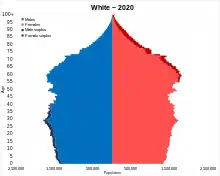

_from_1960_to_2020.gif)
White Americans are the majority racial group in almost all of the United States. They are not the majority in Hawaii, many American Indian reservations, parts of the South, the District of Columbia, all US territories, and in many urban areas throughout the country.
Overall the highest concentration of those referred to as "non-Hispanic whites" by the Census Bureau are found in the Midwest, New England, the northern Rocky Mountain states, Kentucky, West Virginia, and East Tennessee.[58] The lowest concentration of whites was found in southern and mid-Atlantic states.[9][59][60]
Although all large geographical areas are dominated by White Americans, much larger differences can be seen between specific parts of large cities.
States with the highest percentages of White Americans, either White Alone or in combination with another race as of 2020:[61]
- Vermont 95.6%
- Maine 95.4%
- West Virginia 94.4%
- New Hampshire 93.7%
- Wyoming 92.0%
- Montana 90.9%
- Idaho 90.2%
- Iowa 89.8%
- North Dakota 88.0%
- Kentucky 87.5%
States with the highest percentages of non-Latino/Hispanic whites, as of 2020:[62]
- Maine 92.0%
- Vermont 91.3%
- New Hampshire 91.3%
- West Virginia 90.4%
- Wyoming 90.7%
- Idaho 90.7%
- Utah 88.7%
- Iowa 88.7%
- Montana 86.7%
- Nebraska 86.0%
Income and educational attainment
White Americans have the second highest median household income and personal income levels in the nation, by cultural background. The median income per household member was also the highest, since White Americans had the smallest households of any racial demographic in the nation. In 2006, the median individual income of a White American age 25 or older was $33,030, with those who were full-time employed, and of age 25 to 64, earning $34,432. Since 42% of all households had two income earners, the median household income was considerably higher than the median personal income, which was $48,554 in 2005. Jewish Americans rank first in household income, personal income, and educational attainment among White Americans.[63] In 2005, White households had a median household income of $48,977, which is 10% above the national median of $44,389. Among Cuban Americans, with 86% classified as White, those born in the US have a higher median income and educational attainment level than most other Whites.[64]
The poverty rates for White Americans are the second-lowest of any racial group, with 11% of white individuals living below the poverty line, 3% lower than the national average.[65] However, due to Whites' majority status, 48% of Americans living in poverty are white.[66]
White Americans' educational attainment is the second-highest in the country, after Asian Americans'. Overall, nearly one-third of White Americans had a Bachelor's degree, with the educational attainment for Whites being higher for those born outside the United States: 38% of foreign born, and 30% of native born Whites had a college degree. Both figures are above the national average of 27%.[67]
Gender income inequality was the greatest among Whites, with White men outearning White women by 48%. Census Bureau data for 2005 reveals that the median income of White females was lower than that of males of all races. In 2005, the median income for White American females was only slightly higher than that of African American females.[68]
White Americans are more likely to live in suburbs and small cities than their black counterparts.[69]
Population by state
- White American population distribution over time
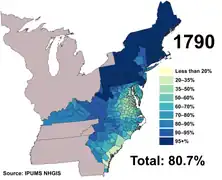 1790
1790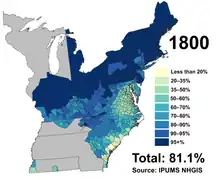 1800
1800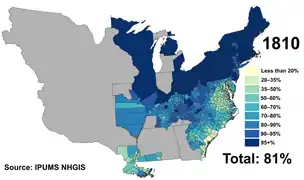 1810
1810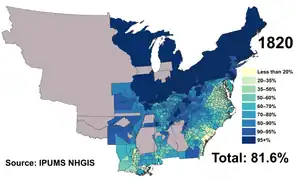 1820
1820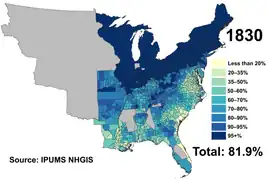 1830
1830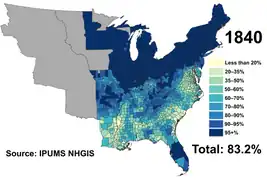 1840
1840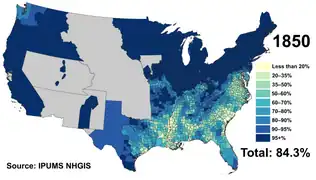 1850
1850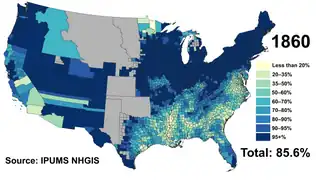 1860
1860 1870
1870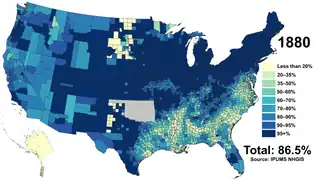 1880
1880 1890
1890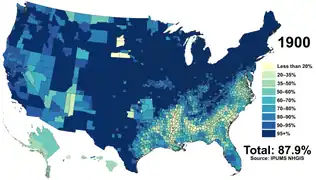 1900
1900 1910
1910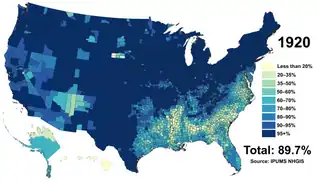 1920
1920 1940
1940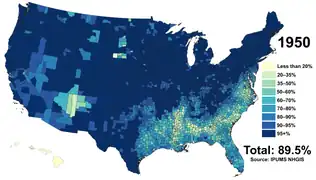 1950
1950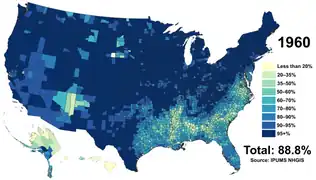 1960
1960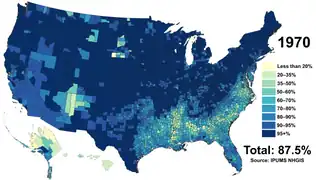 1970
1970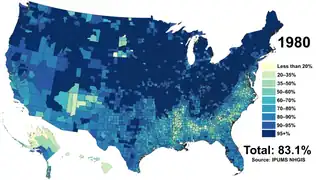 1980
1980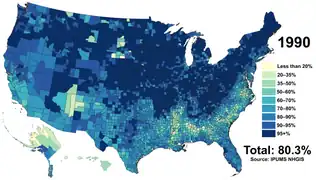 1990
1990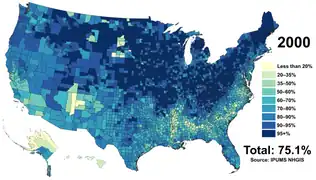 2000
2000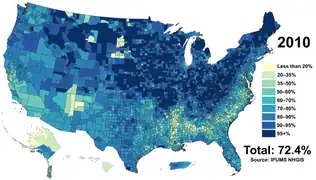 2010
2010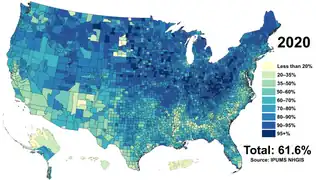 2020
2020
White Americans of one race or alone from 2000 to 2020
| State | 2000 | 2010 | 2020 | Growth | |||
|---|---|---|---|---|---|---|---|
| Pop. 2000 | % 2000 | Pop. 2010 | % 2010 | Pop | % growth between 2000 and 2010 | ||
| 3,162,808 | 71.1% | 3,275,394 | 68.5% | 3,220,452 | 64.1% | +3.6% | |
| 434,534 | 69.3% | 473,576 | 66.7% | 435,392 | 59.4% | +9.0% | |
| 3,873,611 | 75.5% | 4,667,121 | 73.0% | 4,322,337 | 60.4% | +20.5% | |
| 2,138,598 | 80.0% | 2,245,229 | 77.0% | 2,114,512 | 70.2% | +5.0% | |
| 20,170,059 | 59.5% | 21,453,934 | 57.6% | 16,296,122 | 41.2% | +6.4% | |
| 3,560,005 | 82.8% | 4,089,202 | 81.3% | 4,082,927 | 70.7% | +14.9% | |
| 2,780,355 | 81.6% | 2,772,410 | 77.6% | 2,395,128 | 66.4% | -0.3% | |
| 584,773 | 74.6% | 618,617 | 68.9% | 597,763 | 60.4% | +5.8% | |
| 176,101 | 30.8% | 231,471 | 38.5% | 273,194 | 39.4% | +31.4% | |
| 12,465,029 | 78.0% | 14,109,162 | 75.0% | 12,422,961 | 57.7% | +13.2% | |
| 5,327,281 | 65.1% | 5,787,440 | 59.7% | 5,555,483 | 51.9% | +8.6% | |
| 294,102 | 24.3% | 336,599 | 24.7% | 333,261 | 22.9% | +14.4% | |
| 1,177,304 | 91.0% | 1,396,487 | 89.1% | 1,510,360 | 82.1% | +18.6% | |
| 9,125,471 | 73.5% | 9,177,877 | 71.5% | 7,868,227 | 61.4% | +0.6% | |
| 5,320,022 | 87.5% | 5,467,906 | 84.3% | 5,241,791 | 77.2% | +2.8% | |
| 2,748,640 | 93.9% | 2,781,561 | 91.3% | 2,694,521 | 84.5% | +1.2% | |
| 2,313,944 | 86.1% | 2,391,044 | 83.8% | 2,222,462 | 75.6% | +3.3% | |
| 3,640,889 | 90.1% | 3,809,537 | 87.8% | 3,711,254 | 82.4% | +4.6% | |
| 2,856,161 | 63.9% | 2,836,192 | 62.6% | 2,675,652 | 57.1% | -0.7% | |
| 1,236,014 | 96.9% | 1,264,971 | 95.2% | 1,237,041 | 90.8% | +2.3% | |
| 3,391,308 | 64.0% | 3,359,284 | 58.2% | 3,007,874 | 48.7% | -0.9% | |
| 5,367,286 | 84.5% | 5,265,236 | 80.4% | 4,896,037 | 69.6% | -1.9% | |
| 7,966,053 | 80.2% | 7,803,120 | 78.9% | 7,444,974 | 73.9% | -2.0% | |
| 4,400,282 | 89.4% | 4,524,062 | 85.3% | 4,423,146 | 77.5% | +2.8% | |
| 1,746,099 | 61.4% | 1,754,684 | 59.1% | 1,658,893 | 56% | +0.5% | |
| 4,748,083 | 84.9% | 4,958,770 | 82.8% | 4,740,335 | 77% | +4.4% | |
| 817,229 | 90.6% | 884,961 | 89.4% | 916,524 | 84.5% | +8.3% | |
| 1,533,261 | 89.6% | 1,572,838 | 86.1% | 1,538,052 | 78.4% | +2.6% | |
| 1,501,886 | 75.2% | 1,786,688 | 66.2% | 1,588,463 | 51.2% | +19.0% | |
| 1,186,851 | 96.0% | 1,236,050 | 92.3% | 1,216,203 | 88.3% | +4.1% | |
| 6,104,705 | 72.6% | 6,029,248 | 68.6% | 5,112,280 | 55% | -1.2% | |
| 1,214,253 | 66.8% | 1,407,876 | 68.4% | 1,078,927 | 51% | +15.9% | |
| 12,893,689 | 67.9% | 12,740,974 | 65.7% | 11,143,349 | 55.2% | -1.2% | |
| 5,804,656 | 72.1% | 6,528,950 | 68.5% | 6,448,459 | 62.2% | +12.5% | |
| 593,181 | 92.4% | 605,449 | 90.0% | 645,938 | 82.9% | +2.1% | |
| 9,645,453 | 85.0% | 9,539,437 | 82.7% | 9,080,688 | 77% | -1.1% | |
| 2,628,434 | 76.2% | 2,706,845 | 72.2% | 2,514,884 | 63.5% | +3.0% | |
| 2,961,623 | 86.6% | 3,204,614 | 83.6% | 3,169,096 | 74.8% | +8.2% | |
| 10,484,203 | 85.4% | 10,406,288 | 81.9% | 9,750,687 | 75% | -0.7% | |
| 891,191 | 85.0% | 856,869 | 81.4% | 782,920 | 71.3% | -3.8% | |
| 2,695,560 | 67.2% | 3,060,000 | 66.2% | 3,243,442 | 63.4% | +13.5% | |
| 669,404 | 88.7% | 699,392 | 85.9% | 715,336 | 80.7% | +4.5% | |
| 4,563,310 | 80.2% | 4,921,948 | 77.6% | 4,990,938 | 72.2% | +7.9% | |
| 14,799,505 | 71.0% | 17,701,552 | 70.4% | 14,609,365 | 50.1% | +19.6% | |
| 1,992,975 | 89.2% | 2,379,560 | 86.1% | 2,573,413 | 78.7% | +19.4% | |
| 589,208 | 96.8% | 596,292 | 95.3% | 577,751 | 89.8% | +1.2% | |
| 5,120,110 | 72.3% | 5,486,852 | 68.6% | 5,208,856 | 60.3% | +7.2% | |
| 4,821,823 | 81.8% | 5,196,362 | 77.3% | 5,130,920 | 66.6% | +7.8% | |
| 1,718,777 | 95.0% | 1,739,988 | 93.9% | 1,610,749 | 89.8% | +1.2% | |
| 4,769,857 | 88.9% | 4,902,067 | 86.2% | 4,737,545 | 80.4% | +2.8% | |
| 454,670 | 92.1% | 511,279 | 90.7% | 488,374 | 84.7% | +12.4% | |
| 211,460,626 | 75.1% | 223,553,265 | 72.4% | 204,277,273 | 61.6% | +5.7% | |
| State | Pop. 2016 | % 2016 | Pop. 2017 | % 2017 | percentage growth | numeric growth |
|---|---|---|---|---|---|---|
| 3,371,066 | 69.35% | 3,374,131 | 69.22% | -0.13% | +3,065 | |
| 490,864 | 66.20% | 486,724 | 65.79% | -0.41% | -4,140 | |
| 5,753,506 | 83.28% | 5,827,866 | 83.06% | -0.22% | +74,360 | |
| 2,372,843 | 79.41% | 2,381,662 | 79.27% | -0.14% | +3,740 | |
| 28,560,032 | 72.68% | 28,611,160 | 72.37% | -0.31% | +51,128 | |
| 4,837,197 | 87.47% | 4,894,372 | 87.29% | -0.18% | +57,175 | |
| 2,891,943 | 80.60% | 2,879,759 | 80.26% | -0.34% | -12,184 | |
| 667,076 | 70.02% | 670,512 | 69.70% | -0.32% | +3,436 | |
| 305,232 | 44.60% | 313,234 | 45.14% | +0.54% | +8,002 | |
| 16,022,497 | 77.56% | 16,247,613 | 77.43% | -0.13% | +225,116 | |
| 6,310,426 | 61.18% | 6,341,768 | 60.81% | -0.37% | +31,342 | |
| 370,362 | 25.92% | 366,546 | 25.67% | -0.25% | -3,816 | |
| 1,567,868 | 93.32% | 1,599,814 | 93.18% | -0.2% | +31,946 | |
| 9,909,184 | 77.20% | 9,864,942 | 77.06% | -0.14% | -44,242 | |
| 5,679,252 | 85.61% | 5,690,929 | 85.36% | -0.25% | +11,677 | |
| 2,860,136 | 91.35% | 2,864,664 | 91.06% | -0.29% | +4,528 | |
| 2,519,340 | 86.64% | 2,519,176 | 86.47% | -0.17% | -164 | |
| 3,901,878 | 87.96% | 3,908,964 | 87.76% | -0.20% | +7,086 | |
| 2,958,471 | 63.13% | 2,951,003 | 63.00% | -0.13% | -7,468 | |
| 1,261,247 | 94.81% | 1,264,744 | 94.67% | -0.14% | +3,497 | |
| 3,572,673 | 59.30% | 3,568,679 | 58.96% | -0.34% | -3,994 | |
| 5,575,622 | 81.71% | 5,576,725 | 81.29% | -0.42% | +1,103 | |
| 7,906,913 | 79.60% | 7,914,418 | 79.44% | -0.16% | +7,505 | |
| 4,687,397 | 84.84% | 4,708,215 | 84.43% | -0.41% | +20,818 | |
| 1,771,276 | 59.33% | 1,766,950 | 59.21% | -0.12% | -4,326 | |
| 5,069,869 | 83.23% | 5,080,444 | 83.10% | -0.13% | +10,575 | |
| 926,475 | 89.20% | 935,792 | 89.08% | -0.12% | +9,317 | |
| 1,693,622 | 88.78% | 1,700,881 | 88.58% | -0.20% | +7,259 | |
| 2,208,915 | 75.15% | 2,235,657 | 74.57% | -0.58% | +26,742 | |
| 1,251,836 | 93.77% | 1,256,807 | 93.59% | -0.18% | +4,971 | |
| 6,499,057 | 72.38% | 6,489,409 | 72.06% | -0.32% | -9,648 | |
| 1,716,662 | 82.31% | 1,715,623 | 82.16% | -0.15% | -1,039 | |
| 13,856,651 | 69.85% | 13,807,127 | 69.56% | -0.29% | -49,524 | |
| 7,212,423 | 71.01% | 7,276,995 | 70.83% | -0.18% | +64,572 | |
| 663,424 | 87.81% | 661,217 | 87.53% | -0.28% | -2,207 | |
| 9,578,424 | 82.41% | 9,579,207 | 82.16% | -0.25% | +783 | |
| 2,923,751 | 74.56% | 2,921,390 | 74.32% | -0.24% | -2,361 | |
| 3,569,538 | 87.29% | 3,607,515 | 87.08% | -0.21% | +37,977 | |
| 10,525,562 | 82.31% | 10,507,780 | 82.06% | -0.25% | -17,782 | |
| 892,287 | 84.37% | 890,883 | 84.07% | -0.30% | -1,404 | |
| 3,393,346 | 68.2% | 3,440,141 | 68.47% | +0.27% | +46,795 | |
| 733,199 | 85.10% | 738,554 | 84.92% | -0.18% | +5,355 | |
| 5,231,987 | 78.68% | 5,276,748 | 78.57% | -0.11% | +44,761 | |
| 22,166,782 | 79.44% | 22,404,118 | 79.15% | -0.29% | +237,336 | |
| 2,774,606 | 91.14% | 2,820,387 | 90.93% | -0.21% | +45,781 | |
| 589,836 | 94.62% | 589,163 | 94.47% | -0.15% | -673 | |
| 5,891,174 | 70.01% | 5,904,472 | 69.71% | -0.30% | +13,298 | |
| 5,820,007 | 79.93% | 5,887,060 | 79.49% | -0.44% | +67,053 | |
| 1,712,647 | 93.66% | 1,699,266 | 93.58% | -0.08% | -13,381 | |
| 5,049,698 | 87.47% | 5,060,891 | 87.32% | -0.15% | +11,193 | |
| 543,224 | 92.87% | 537,396 | 92.76% | -0.11% | -5,828 | |
| 248,619,303 | 76.87% | 249,619,493 | 76.64% | -0.23% | +1,000,190 |
Non-Hispanic population
| State | Pop. 2016 | % 2016 | Pop. 2017 | % 2017 | percentage growth | numeric growth |
|---|---|---|---|---|---|---|
| 3,198,381 | 65.80% | 3,196,852 | 65.58% | -0.22% | -1,529 | |
| 454,651 | 61.31% | 449,776 | 60.80% | -0.51% | -4,875 | |
| 3,819,881 | 55.29% | 3,849,130 | 54.86% | -0.43% | +29,249 | |
| 2,175,521 | 72.80% | 2,177,809 | 72.49% | -0.31% | +2,288 | |
| 14,797,971 | 37.66% | 14,696,754 | 37.17% | -0.49% | -101,217 | |
| 3,791,612 | 68.56% | 3,827,750 | 68.26% | -0.30% | +36,135 | |
| 2,428,332 | 67.68% | 2,404,792 | 67.02% | -0.66% | -23,540 | |
| 597,728 | 62.74% | 599,260 | 62.30% | -0.44% | +1,532 | |
| 249,141 | 36.40% | 255,387 | 36.80% | +0.40% | +6,246 | |
| 11,273,388 | 54.57% | 11,343,977 | 54.06% | -0.51% | +70,589 | |
| 5,499,055 | 53.32% | 5,507,334 | 52.81% | -0.51% | +8,279 | |
| 317,026 | 22.19% | 312,492 | 21.89% | -0.30% | -4,534 | |
| 1,382,934 | 82.32% | 1,408,294 | 82.02% | -0.30% | +25,360 | |
| 7,915,013 | 61.65% | 7,849,887 | 61.32% | -0.33% | -65,126 | |
| 5,280,029 | 79.59% | 5,280,420 | 79.20% | -0.39% | +391 | |
| 2,696,686 | 86.13% | 2,695,962 | 85.70% | -0.43% | -724 | |
| 2,215,920 | 76.21% | 2,209,748 | 75.86% | -0.35% | -6,172 | |
| 3,767,092 | 84.92% | 3,768,891 | 84.61% | -0.31% | +1,799 | |
| 2,760,416 | 58.91% | 2,747,730 | 58.66% | -0.25% | -12,686 | |
| 1,243,741 | 93.50% | 1,246,478 | 93.30% | -0.20% | +2,737 | |
| 3,098,543 | 51.43% | 3,077,907 | 50.86% | -0.57% | -20,636 | |
| 4,972,010 | 72.86% | 4,953,695 | 72.21% | -0.65% | -18,315 | |
| 7,489,609 | 75.40% | 7,488,326 | 75.17% | -0.23% | -1,283 | |
| 4,442,684 | 80.41% | 4,455,605 | 79.89% | -0.52% | +12,921 | |
| 1,697,562 | 56.86% | 1,691,566 | 56.69% | -0.17% | -5,996 | |
| 4,855,156 | 79.71% | 4,859,227 | 79.48% | -0.23% | +4,071 | |
| 897,790 | 86.44% | 905,811 | 86.23% | -0.21% | +8,021 | |
| 1,515,494 | 79.44% | 1,516,962 | 79.00% | -0.44% | +1,468 | |
| 1,465,888 | 49.87% | 1,470,855 | 49.06% | -0.81% | +4,967 | |
| 1,212,377 | 90.81% | 1,215,447 | 90.52% | -0.29% | +3,070 | |
| 5,002,866 | 55.72% | 4,962,470 | 55.10% | -0.62% | -40,396 | |
| 789,869 | 38.31% | 783,064 | 37.50% | -0.81% | -6,805 | |
| 11,047,456 | 55.69% | 10,972,959 | 55.28% | -0.41% | -74,497 | |
| 6,447,852 | 63.48% | 6,486,100 | 63.13% | -0.35% | +38,248 | |
| 641,945 | 84.96% | 639,029 | 84.59% | -0.37% | -2,916 | |
| 9,229,932 | 79.41% | 9,219,577 | 79.08% | -0.33% | -10,355 | |
| 2,592,571 | 66.12% | 2,581,568 | 65.67% | -0.45% | -11,003 | |
| 3,115,656 | 76.25% | 3,139,685 | 75.79% | -0.46% | +24,029 | |
| 9,841,619 | 76.96% | 9,796,510 | 76.50% | -0.44% | -45,109 | |
| 773,405 | 73.13% | 768,229 | 72.50% | -0.63% | -5,176 | |
| 3,165,176 | 63.82% | 3,203,045 | 63.75% | -0.07% | +37,869 | |
| 710,509 | 82.47% | 714,881 | 82.20% | -0.27% | +4,372 | |
| 4,931,609 | 74.17% | 4,963,780 | 73.91% | -0.26% | +32,171 | |
| 11,862,697 | 42.51% | 11,886,381 | 42.00% | -0.51% | +23,684 | |
| 2,400,885 | 78.86% | 2,434,785 | 78.49% | -0.37% | +33,900 | |
| 580,238 | 93.08% | 579,149 | 92.86% | -0.22% | -1,089 | |
| 5,247,231 | 62.36% | 5,241,262 | 61.88% | -0.48% | -5,969 | |
| 5,049,817 | 69.36% | 5,091,370 | 68.75% | -0.61% | +41,553 | |
| 1,688,472 | 92.33% | 1,674,557 | 92.22% | -0.11% | -13,915 | |
| 4,710,928 | 81.60% | 4,713,993 | 81.34% | -0.26% | +3,065 | |
| 492,235 | 84.16% | 486,565 | 83.99% | -0.17% | -5,670 | |
| 197,834,599 | 61.17% | 197,803,083 | 60.73% | -0.44% | -31,516 |
Politics
White Americans tend to vote for the Republican Party ever since the 1960s when the party pushed for the Southern strategy electoral strategy to increase political support among white voters in the South.
In 2012, 88% of Romney voters were white while 56% of Obama voters were white.[73] In the 2008 presidential election, John McCain won 55% of white votes.[74] In the 2010 House election, Republicans won 60% of the white votes.[75]
Some academics and commentators have argued that Donald Trump's presidential election victory in 2016 is an example of "White backlash".[76][77][78]
| Year | Candidate of the plurality |
Political party |
% of White vote |
Result |
|---|---|---|---|---|
| 1980 | Ronald Reagan | Republican Party | 56% | Won |
| 1984 | Ronald Reagan | Republican | 66% | Won |
| 1988 | George H. W. Bush | Republican | 59% | Won |
| 1992 | George H. W. Bush | Republican | 40% | Lost |
| 1996 | Bob Dole | Republican | 46% | Lost |
| 2000 | George W. Bush | Republican | 55% | Won |
| 2004 | George W. Bush | Republican | 58% | Won |
| 2008 | John McCain | Republican | 55% | Lost |
| 2012 | Mitt Romney | Republican | 59% | Lost |
| 2016 | Donald Trump | Republican | 57% | Won |
| 2020 | Donald Trump | Republican | 58% | Lost |
Culture
From their earliest presence in North America, White Americans have contributed literature, art, cinema, religion, agricultural skills, foods, science and technology, fashion and clothing styles, music, language, legal system, political system, and social and technological innovation to American culture. White American culture derived its earliest influences from English, Scottish, Welsh, and Irish settlers and is quantitatively the largest proportion of American culture.[79] The overall American culture reflects White American culture. The culture has been developing since long before the United States formed a separate country. Much of White American culture shows influences from British culture. Colonial ties to Great Britain spread the English language, legal system and other cultural attributes.[80]
Albion's Seed: Four British Folkways in America

In his 1989 book Albion's Seed: Four British Folkways in America, David Hackett Fischer explores the details of the folkways of four groups of settlers from the British Isles that moved to the American colonies during the 17th and 18th centuries from distinct regions of Britain and Ireland. His thesis is that the culture of each group persisted (albeit in modified form), providing the basis for the modern United States.[81]
According to Fischer, the foundation of America's four regional cultures was formed from four mass migrations from four regions of the British Isles by four distinct ethno-cultural groups. New England's formative period occurred between 1629 and 1640 when Puritans, mostly from East Anglia, settled there, thus forming the basis for the New England regional culture.[82] The next mass migration was of southern English Cavaliers and their working class English servants to the Chesapeake Bay region between 1640 and 1675. This spawned the creation of the American Southern culture.[83]
Then, between 1675 and 1725, thousands of Irish, Cornish, English and Welsh Quakers plus many Germans sympathetic to Quaker ideas, led by William Penn, settled the Delaware Valley. This resulted in the formation of the General American culture, although, according to Fischer, this is really a "regional culture", even if it does today encompass most of the U.S. from the mid-Atlantic states to the Pacific Coast.[84] Finally, a huge number of settlers from the borderlands between England and Scotland, sometimes by way of northern Ireland, migrated to Appalachia between 1717 and 1775. This resulted in the formation of the Upland South regional culture, which has since expanded to the west to West Texas and parts of the American Southwest.[85]
In his book, Fischer brings up several points. He states that the U.S. is not a country with one "general" culture and several "regional" cultures, as is commonly thought. Rather, there are only four regional cultures as described above, and understanding this helps one to more clearly understand American history as well as contemporary American life. Fischer asserts that it is not only important to understand where different groups came from, but when. All population groups have, at different times, their own unique set of beliefs, fears, hopes and prejudices. When different groups moved to America and brought certain beliefs and values with them, these ideas became, according to Fischer, more or less frozen in time, even if they eventually changed in their original place of origin.[86]
Admixture
Admixture in non-Hispanic whites
White Americans have a mean of 98.6% European, 0.19% sub-Saharan African, and 0.18% Native American ancestry.[87] However, non-European ancestry in White Americans is highly variable; for example, Black ancestry (2% or greater) is found in over five percent of European Americans in Louisiana and South Carolina, and Native American ancestry (2% or greater) is found in over three percent of European Americans in Louisiana and North Dakota. African ancestry is most common in the South and least common in the Midwest; Native American ancestry is more common in Western states than Eastern states.[88]
Older studies have also been performed. DNA analysis on White Americans by geneticist Mark D. Shriver showed an average of 0.7% sub-Saharan African admixture and 3.2% Native American admixture.[89] The same author, in another study, claimed that about 30% of all White Americans, approximately 66 million people, have a median of 2.3% of Black African admixture.[90] Shriver discovered his ancestry is 10 percent African, and Shriver's partner in DNA Print Genomics, J.T. Frudacas, contradicted him two years later stating "Five percent of European Americans exhibit some detectable level of African ancestry."[91]
In a 2007 study, Gonçalves et al. reported sub-Saharan and Amerindian mtDNA lineages at a frequency of 3.1% (respectively 0.9% and 2.2%) in a sample of 1387 American Caucasians as compared to 62% in white Brazilians (respectively 29% and 33%), 98% for white Colombians (respectively 8% and 90%) and similarly high levels for Argentines, Chileans, and Costa Ricans.[92] A 2003 study on Y-chromosomes and mtDNA found African admixture in European Americans to be "below the limits of detection".[93]
Admixture in Hispanic whites
In contrast to non-Hispanic or Latino whites, whose average European ancestry is 98.6%,[94][95] genetic research has found that the average European admixture among White Hispanic and Latino Americans is 73%, while the average European admixture for Hispanic Americans overall (regardless of their self-identified race) is 65.1%.
See also
- American ancestry
- Anglo
- Emigration from Europe
- European Americans
- Hyphenated American
- Middle Eastern Americans
- Non-Hispanic or Latino whites
- Race and ethnicity in the United States
- Racism in the United States
- Stereotypes of white Americans
- White Anglo-Saxon Protestant
- White ethnic
- White Latino Americans
- White Puerto Ricans
- White Southerners
- List of United States cities by percentage of white population
- White Americans in California
- White Americans in Maryland
- White Americans in Texas
Notes
References
- ↑ "2020 Census Redistricting: Supplementary Tables". United States Census Bureau. August 12, 2021. Archived from the original on September 18, 2021. Retrieved September 6, 2021.
- ↑ "Religious tradition by race/ethnicity (2014)". The Pew Forum on Religion & Public Life. Retrieved April 5, 2019.
- ↑ "QuickFacts: United States". www.census.gov.
- ↑ Bureau, US Census. "2020 Census Illuminates Racial and Ethnic Composition of the Country". Census.gov. Retrieved April 15, 2023.
- ↑ "Methodology for the United States Population Estimates: Vintage 2022" (PDF). US Census Bureau. December 2022. Retrieved April 15, 2023.
- 1 2 3 "Analysis | There's a big problem with how the census measures race". The Washington Post. February 6, 2018. Retrieved July 23, 2021.
- 1 2 3 Demby, Gene (June 16, 2014). "On The Census, Who Checks 'Hispanic,' Who Checks 'White,' And Why". NPR.org. Retrieved July 23, 2021.
- 1 2 3 Karen R. Humes; Nicholas A. Jones; Roberto R. Ramirez, eds. (March 2011). "Definition of Race Categories Used in the 2010 Census" (PDF). United States Census Bureau. p. 3. Retrieved September 8, 2013.
- 1 2 "The White Population: 2000" (PDF). United States Census Bureau. August 2001. Retrieved March 10, 2011.
- ↑ "Public Comments Received on Federal Register notice 79 FR 71377: Proposed Information Collection; Comment Request; 2015 National Content Test" (PDF). Census.gov. December 2, 2014 – February 2, 2015. Retrieved October 29, 2019.
- ↑ "Census Bureau explores new Middle East/North Africa ethnic category". Pewresearch.org. March 24, 2014. Retrieved November 6, 2017.
- ↑ Sources:
- Korelitz, Seth (March 1997). "The Menorah Idea: From Religion to Culture, from Race to Ethnicity". American Jewish History. The Johns Hopkins University Press. 85 (1): 75–100. ISSN 0164-0178. JSTOR 23885597.
- Novick, Peter (September 20, 2000). The Holocaust in American Life. Houghton Mifflin Harcourt. pp. 127–32. ISBN 978-0-547-34961-9.
- Siporin, Steve (November 1990). "Immigrant and Ethnic Family Folklore, Western States Jewish History". Western Historical Quarterly. Oxford University Press. 21 (4): 230–42. JSTOR 969273.
- Lerner, Michael (May 18, 1993). "Jews Are Not White". The Village Voice.
In America, to be 'white' means to be the beneficiary of the past 500 years of European exploration and exploitation of the rest of the world
- ↑ Sources:
- Thompson, Derek (August 19, 2008). "Do white people really come from the Caucasus?". Slate. Retrieved March 10, 2011.
Caucasians included most Europeans, Northern Africans, and Asians as far east as the Ganges Delta in modern India.
- Lee, Sandra Soo-Jin; Mountain, Joanna; Koenig, Barbara A. (2001). "The meanings of "race" in the new genomics: Implications for health disparities research" (PDF). Yale Journal of Health Policy, Law, and Ethics. 1: 33–75. PMID 12669320. Archived from the original (PDF) on March 3, 2016.
- Reynolds Farley, 'The New Census Question about Ancestry: What Did It Tell Us?', Demography, Vol. 28, No. 3 (August 1991), pp. 414, 421.
- Stanley Lieberson and Lawrence Santi, 'The Use of Nativity Data to Estimate Ethnic Characteristics and Patterns', Social Science Research, Vol. 14, No. 1 (1985), pp. 44–46.
- Thompson, Derek (August 19, 2008). "Do white people really come from the Caucasus?". Slate. Retrieved March 10, 2011.
- 1 2 3 Lieberson, Stanley; Waters, Mary C. (September 1986). "Ethnic Groups in Flux: The Changing Ethnic Responses of American Whites". Annals of the American Academy of Political and Social Science. 487 (79, Immigration and American Public Policy): 82–86. doi:10.1177/0002716286487001004. ISSN 0002-7162. JSTOR 1046054. OCLC 4649763967. S2CID 60711423.
- ↑ "Race".
- ↑ Bhopal, R.; Donaldson, L. (1998). "White, European, Western, Caucasian, or what? Inappropriate labeling in research on race, ethnicity, and health". American Journal of Public Health. 88 (9): 1303–1307. doi:10.2105/ajph.88.9.1303. PMC 1509085. PMID 9736867.
- ↑ Baum 2006, p. 3,18.
- ↑ Bureau, U.S. Census. "U.S. Census website". United States Census Bureau. Retrieved August 29, 2017.
- ↑ Bureau, U.S. Census. "American FactFinder – Search". Archived from the original on February 11, 2020. Retrieved November 7, 2009.
- ↑ Sharon R. Ennis; Ríos-Vargas, Merarys; Nora G. Albert (May 2011). "U.S. Census Bureau" (PDF). p. 14. Retrieved July 11, 2011.
- ↑ "Selected Social Characteristics in the United States: 2007". U.S. Census American Community Survey. 2007. Archived from the original on February 11, 2020. Retrieved October 5, 2020.
- ↑ 2021 Community Survey, Table B03001: Hispanic or Latino Origin by Specific Origin
- ↑ Sources:
- Pulera, Dominic (October 20, 2004). Sharing the Dream: White Males in Multicultural America. A&C Black. p. 57. ISBN 978-0-8264-1643-8. Retrieved October 22, 2016.
- Reynolds Farley, 'The New Census Question about Ancestry: What Did It Tell Us?', Demography, Vol. 28, No. 3 (August 1991), pp. 414, 421.
- Stanley Lieberson and Lawrence Santi, 'The Use of Nativity Data to Estimate Ethnic Characteristics and Patterns', Social Science Research, Vol. 14, No. 1 (1985), pp. 44–46.
- ↑ "Questions and Answers for Census 2000 Data on Race". Archived from the original on March 4, 2010. Retrieved April 25, 2010.
- ↑ "American FactFinder Help". United States Census Bureau. Archived from the original on March 5, 2001. Retrieved November 11, 2008.
Origin can be viewed as the heritage, nationality group, lineage, or country of birth of the person or the person's parents or ancestors before their arrival in the United States. People who identify their origin as Spanish, Hispanic, or Latino may be of any race.
- ↑ "Overview of Race and Hispanic Origin: 2000" (PDF). Census.gov. Retrieved October 22, 2016.
- ↑ "T4-2008. Hispanic or Latino By Race". 2008 Population Estimates. U.S. Census Bureau. Retrieved March 15, 2010.
- ↑ "B03002. HISPANIC OR LATINO ORIGIN BY RACE". 2008 American Community Survey 1-Year Estimates. U.S. Census Bureau. Retrieved March 16, 2010.
- ↑ "U.S. Bureau of the Census, Population, Volume II: General Report, Statistics by Subjects". Washington, D.C.: Government Printing Office. 1933: 27.
{{cite journal}}: Cite journal requires|journal=(help) - ↑ "Measuring Race and Ethnicity Across the Decades: 1790-2010, Mapped to 1997 U.S. Office of Management and Budget Classification Standards". The United States Census Bureau.
- ↑ Bashi Treitler, Vilna Francine. "The Race Question". Rutgers University Faculty Webpages. Archived from the original on October 7, 2008.
- ↑ "Public Comments Received on Federal Register notice 79 FR 71377: Proposed Information Collection; Comment Request; 2015 National Content Test" (PDF). Census.gov. December 2, 2014 – February 2, 2015. Retrieved October 29, 2019.
- ↑ "Not Quite White: Race Classification and the Arab American Experience – Arab American Institute". Aaiusa.org. Archived from the original on May 27, 2020. Retrieved December 14, 2017.
- ↑ "Lobbying for a 'MENA' category on U.S. Census". USA Today. August 13, 2014.
- ↑ "Why Arab Americans are pushing for a 'Middle East or North African' category on the census". PBS. April 28, 2023.
- ↑ "Surveillance Epidemiology and End Results. Race and Nationality Descriptions from the 2000 Census and Bureau of Vital Statistics" (PDF). Seer.cancer.gov. May 21, 2007. Retrieved October 22, 2016.
- ↑ "Clark Library | U-M Library". Lib.umich.edu. Archived from the original on March 13, 2005. Retrieved June 5, 2023.
- ↑ "Access Data: Public Use Microdata (PUMS): 2005 PUMS Code Lists: Ancestry Codes". Archived from the original on September 16, 2008. Retrieved August 22, 2008.
- ↑ Ajrouch, Kristine J. (2016). "Gender, Race, and Symbolic Boundaries: Contested Spaces of Identity among Arab American Adolescents". Sociological Perspectives. 47 (4): 371–391. doi:10.1525/sop.2004.47.4.371. S2CID 143001730.
- ↑ Seth Korelitz, "The Menorah Idea: From Religion to Culture, From Race to Ethnicity," American Jewish History 1997 85(1): 75–100. 0164–0178
- ↑ Peter Novick, The Holocaust in American Life (1999); Hilene Flanzbaum, ed. The Americanization of the Holocaust (1999); Monty Noam Penkower, "Shaping Holocaust Memory," American Jewish History 2000 88(1): 127–132. 0164–0178
- ↑ Steve Siporin, "Immigrant and Ethnic Family Folklore," Western States Jewish History 1990 22(3): 230–242. 0749–5471
- ↑ M. Lerner, Village Voice, 1993
- 1 2 Armas Kustaa Ensio Holmio, "History of the Finns in Michigan", p. 17
- ↑ Franklin, Benjamin (1751). Observations concerning the increase of mankind, peopling of countries, &c. Tarrytown, N.Y., Reprinted, W. Abbatt. p. 224.
- ↑ Tehranian, John (January 2000). "Performing Whiteness: Naturalization Litigation and the Construction of Racial Identity in America". Yale Law Journal. New Haven, Connecticut: The Yale Law Journal Company, Inc. 109 (4): 825. doi:10.2307/797505. ISSN 0044-0094. JSTOR 797505. OCLC 5544418733. Archived from the original on September 4, 2020. HeinOnline link
 .
. - ↑ Roediger, Wages of Whiteness, 186; Tony Horwitz, Confederates in the Attic: Dispatches from the Unfinished Civil War (New York, 1998).
- ↑ Sweet, Frank W. Legal History of the Color Line: The Notion of Invisible Blackness. Backintyme Publishers (2005), ISBN 0-939479-23-0.
- ↑ "Official census statistics of the United States race and Hispanic origin population" (PDF). Census.gov. Archived from the original (PDF) on November 14, 2014.
- ↑ "Census 2000 Summary File 1 (SF 1) 100-Percent Data Geographic Area: United States". Census.gov. Archived from the original on February 12, 2020. Retrieved April 5, 2009.
- 1 2 "The White Population: 2000" (PDF). Census.gov. Archived from the original (PDF) on June 25, 2005.
- ↑ "Overview of Race and Hispanic Origin: 2010" (PDF). Census.gov. Archived from the original (PDF) on May 5, 2011.
- ↑ Hixson, Lindsay; Bradford B. Hepler; Myoung Ouk Kim (September 2011). "The White Population: 2010" (PDF). United States Census Bureau. United States Department of Commerce. Retrieved November 20, 2012.
- ↑ Grieco, Elizabeth M.; Acosta, Yesenia D.; de la Cruz, G. Patricia; Gambino, Christine; Gryn, Thomas; Larsen, Luke J.; Trevelyan, Edward N.; Walters, Nathan P. (May 2012). "The Foreign-Born Population in the United States: 2010" (PDF). Census.gov. United States Census Bureau. Archived from the original (PDF) on May 11, 2012.
- ↑ "United States Population Projections By Race and Hispanic Origin: 2000 TO 2050" (PDF). United States Census Bureau. Archived from the original (Excel) on March 6, 2008. Retrieved May 5, 2008.
- ↑ "Ancestry of the Population by State: 1980 – Table 3" (PDF). Census.gov. Retrieved October 22, 2016.
- ↑ Fischer, David Hackett (1989). Albion's Seed: Four British Folkways in America. New York: Oxford University Press. pp. 633–39. ISBN 978-0-19-503794-4.
- ↑ Chokshi, Niraj (June 30, 2014). "Diversity in America's counties, in 5 maps". The Washington Post. Washington, D.C. Retrieved October 26, 2019.
- ↑ Brewer, Cynthia; Suchan, Trudy (2001). Census 2000, The Geography of US Diversity. Redlands, California: ESRI Press.
- ↑ "Distribution of those identifying as White alone, by state, US Census Bureau". Archived from the original on May 5, 2007. Retrieved October 5, 2006.
- ↑ "United States – States; and Puerto Rico: Percent of the Total Population Who Are White Alone 2007". Census.gov. Archived from the original on July 17, 2009. Retrieved January 5, 2009.
- ↑ "American FactFinder". U.S. Census Bureau. Archived from the original on November 20, 2011. Retrieved January 16, 2011.
- ↑ "New Study Claims US Jews Have Reasons to Be Proud". Israelnationalnews.com. June 25, 2008. Retrieved October 22, 2016.
- ↑ "Cuba Fact Sheet Final Draft 08252006 _3_.doc" (PDF). Pewhispanic.org. Archived from the original (PDF) on May 30, 2009. Retrieved October 22, 2016.
- ↑ "Income, Poverty, and Health Insurance Coverage in the United States: 2004" (PDF). Census.gov. Retrieved October 22, 2016.
- ↑ "Rural Poverty: Myths and Realities". Archived from the original on July 4, 2007. Retrieved June 5, 2007.
- ↑ "US Census Bureau report on educational attainment in the United States, 2003" (PDF). Retrieved December 23, 2006.
- ↑ "US Census Bureau, Personal income forum, Age 25+, 2005". Archived from the original on January 4, 2007. Retrieved January 20, 2007.
- ↑ Kahn, Matthew E.; Bajari, Patrick (2001). "Why Do Blacks Live in the Cities and Whites Live in the Suburbs?". SSRN Electronic Journal. doi:10.2139/ssrn.263049. S2CID 55740758.
- ↑ "American FactFinder". August 31, 2004. Archived from the original on August 31, 2004. Retrieved June 28, 2022.
- ↑ Bureau, US Census. "Race and Ethnicity in the United States: 2010 Census and 2020 Census". Census.gov. Retrieved June 28, 2022.
- 1 2 "Annual Estimates of the Resident Population by Sex, Race, and Hispanic Origin for the United States, States, and Counties: April 1, 2010 to July 1, 2017: 2017 Population Estimates". American FactFinder. Archived from the original on August 19, 2018. Retrieved August 29, 2017.
- ↑ Tom Scocca, "Eighty-Eight Percent of Romney Voters Were White", Slate November 7, 2012 Archived July 6, 2015, at the Wayback Machine
- ↑ "Dissecting the 2008 Electorate: Most Diverse in U.S. History" Archived June 18, 2012, at the Wayback Machine. Pew Research Center. April 30, 2009.
- ↑ "The Latino Vote in the 2010 Elections". Pew Research Center. November 3, 2010. Archived from the original on February 5, 2011. Retrieved January 30, 2011.
- ↑ II, Vann R. Newkirk (January 15, 2018). "Five Decades of White Backlash". The Atlantic. Retrieved February 16, 2018.
- ↑ Blake, John (January 8, 2018). "How Trump became 'the white affirmative action president'". CNN. Video by Tawanda Scott Sambou. Retrieved February 16, 2018.
- ↑ Baccini, Leonardo; Weymouth, Stephen (2021). "Gone For Good: Deindustrialization, White Voter Backlash, and US Presidential Voting". American Political Science Review. 115 (2): 550–567. doi:10.1017/S0003055421000022. S2CID 204870213.
Deindustrialization in the US, and the associated localized deterioration in employment, wages, and communities, appear central to the white voter backlash that culminated in the election of Donald Trump.
- ↑ "European Influences on Colonial American Culture". pbslearningmedia.org.
- ↑ James B. Minahan (March 14, 2013). Ethnic Groups of the Americas: An Encyclopedia: An Encyclopedia. Abc-Clio. p. 9. ISBN 978-1-61069-164-2. Retrieved October 22, 2016.
- ↑ David Hackett Fischer, Albion's Seed (Oxford University Press, 1989), p. 6
- ↑ Fischer, Albion's Seed, pp. 13–206
- ↑ Fischer, Albion's Seed pp. 207–418
- ↑ Fischer, Albion's Seed, pp. 419–604
- ↑ Fischer, Albion's Seed, pp. 605–782
- ↑ Hackett Fischer, David. Albion's Seed Oxford University Press, 1989.
- ↑ Bryc, K. (2015). "The Genetic Ancestry of African Americans, Latinos, and European Americans across the United States". The American Journal of Human Genetics. Elsevier BV. 96 (1): 42. doi:10.1016/j.ajhg.2014.11.010. ISSN 0002-9297. PMC 4289685. PMID 25529636.
- ↑ Bryc 2015: Figure 3
- ↑ Shriver, Mark D.; Parra, Esteban J.; Dios, Sonia; Bonilla, Carolina; Norton, Heather; Jovel, Celina; Pfaff, Carrie; Jones, Cecily; Massac, Aisha; Cameron, Neil; Baron, Archie; Jackson, Tabitha; Argyropoulos, George; Jin, Li; Hoggart, Clive J.; McKeigue, Paul M.; Kittles, Rick A. (2003). "Skin pigmentation, biogeographical ancestry and admixture mapping". Human Genetics. 112 (4): 387–399. doi:10.1007/s00439-002-0896-y. PMID 12579416. S2CID 7877572.
- ↑ Sailer, Steve (May 8, 2002). "Analysis: White prof finds he's not". UPI.
- ↑ Jim Wooten, "Race Reversal Man Lives as 'Black' for 50 Years — Then Finds Out He's Probably Not, ABC News (2004).
- ↑ Sample of 1387 American Caucasian individuals catalogued in the FBI mtDNA population database, Gonçalves, V. F.; Prosdocimi, F.; Santos, L. S.; Ortega, J. M.; Pena, S. D. (2007). "Sex-biased gene flow in African Americans but not in American Caucasians". Genetics and Molecular Research. 6 (2): 256–261. PMID 17573655.
- ↑ Kayser, M.; Brauer, S.; Schädlich, H.; Prinz, M.; Batzer, M. A.; Zimmerman, P. A.; Boatin, B. A.; Stoneking, M. (2003). "Y Chromosome STR Haplotypes and the Genetic Structure of U.S. Populations of African, European, and Hispanic Ancestry". Genome Research. 13 (4): 624–634. doi:10.1101/gr.463003. PMC 430174. PMID 12671003.
- ↑ Bryc, Katarzyna; Durand, Eric Y.; Macpherson, J. Michael; Reich, David; Mountain, Joanna L. (September 18, 2014). "The genetic ancestry of African, Latino, and European Americans across the United States". bioRxiv 10.1101/009340.. "Supplemental Tables and Figures". p. 42. September 18, 2014. Retrieved July 16, 2015.
- ↑ Zimmer, Carl (December 24, 2014). "White? Black? A Murky Distinction Grows Still Murkie". The New York Times. Retrieved October 24, 2015.
External links
- White Population 2000 from the US Census
